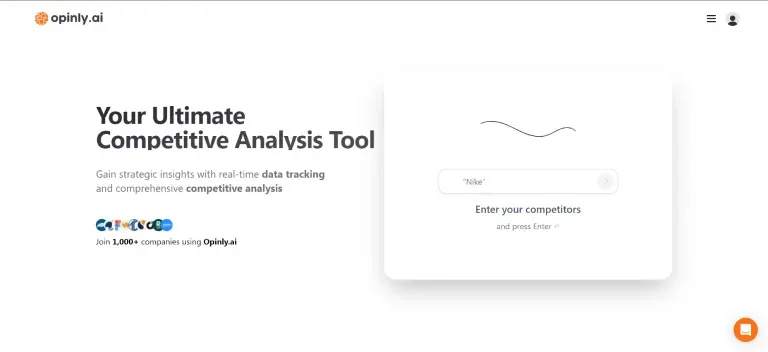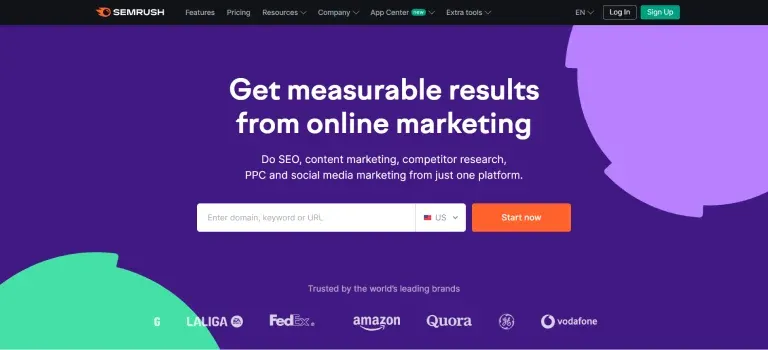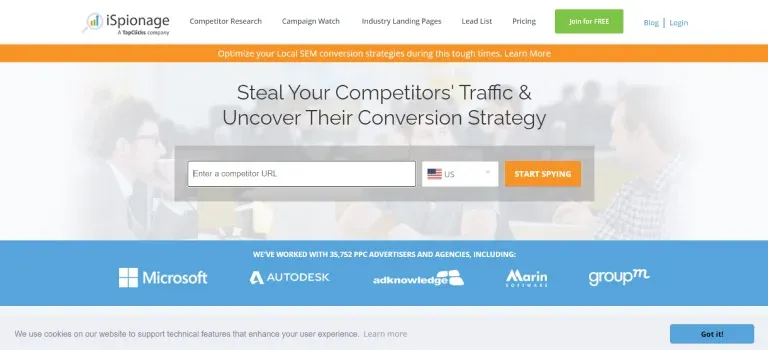Top 10 Software Competitor Analysis Tools: Features and Benefits
Discover the top 10 software competitor analysis tools that will give you the edge in SEO and content strategy. Find the best tools on the market here!

Have you ever wondered how top companies stay ahead of their competitors?
Analyzing your software competitors is crucial in today's digital age. It helps you understand their strengths and weaknesses, so you can make better decisions and stay ahead in the tech industry. - David McGuckin, Software Developer at Opinly AI and v0 Report
The secret often lies in using advanced software competitor analysis tools. In today's fast-paced digital landscape, having the right competitive intelligence software can make all the difference in understanding market trends, monitoring competitor activities, and making informed business decisions.
In this blog, "Top 10 Software Competitor Analysis Tools: Features and Benefits," we'll explore the best software competitor analytics tools available that can give your business the competitive edge it needs.
From detailed feature breakdowns to the benefits they offer, you'll discover how these competitive intelligence tool tools can transform your competitive research strategy and keep your social media platforms ahead of the game. Let's dive in and find the perfect software competitor monitoring tool for your business needs!
What is a Software Competitor Analysis Tool?
A Software Competitor Analysis Tool is an application that helps businesses keep an eye on their competition. It tracks what competitors are doing, such as their pricing, marketing strategies, product releases, and customer feedback. By using this tool, businesses can gather valuable insights, make better decisions, and stay ahead in the market.
Top 10 Software Competitor Analysis Tools
1. Opinly AI

Opinly AI provides a complete suite of tools to keep you ahead of your competitors. With real-time data tracking, you can instantly see market changes and respond quickly. The dynamic pricing feature ensures you stay competitive, and SEO and email monitoring help you stay on top of marketing strategies.
Pros:
- Real-time data tracking
- Comprehensive competitor analysis
- Dynamic pricing adjustments
- SEO and email monitoring
2. SEMrush

SEMrush offers powerful tools to enhance your online visibility. Its keyword research and backlink analysis help you understand your competitors’ SEO strategies, while the advertising insights allow you to optimize your marketing campaigns.
Pros:
- Extensive keyword research and social listening capabilities
- Detailed backlink analysis
- Competitive advertising insights
3. Ahrefs

Ahrefs is known for its deep backlink analysis and content research capabilities. It helps you discover what content performs best in your industry and how to improve your link-building strategy to outrank competitors.
Pros:
- Robust site explorer tool
- Comprehensive content analysis
- Backlink monitoring
4. SpyFu

SpyFu allows you to dive deep into your competitors’ paid search strategies. With access to historical data, you can see what has worked for them over time and adjust your campaigns for better results.
Pros:
- Detailed PPC competitor research
- Historical data on competitors’ ads
- Keyword ranking tracking
5. SimilarWeb

SimilarWeb provides a clear view of your competitors’ online performance. Understanding traffic sources and audience demographics helps you refine your marketing strategies and identify new growth opportunities.
Pros:
- Website traffic insights
- Audience demographics
- Competitive landscape analysis
6. BuzzSumo

BuzzSumo excels at analyzing content performance and social media engagement. It helps you find the most engaging content and influential figures in your niche, allowing you to tailor your content strategy for maximum impact.
Pros:
- Content performance analysis
- Social media insights
- Influencer identification
7. Moz Pro

Moz Pro is a comprehensive SEO tool that offers detailed site audits, keyword research, and rank tracking. These features help you improve your search engine rankings and stay ahead of the competition.
Pros:
- SEO audit and optimization
- Keyword explorer tool
- Rank tracking
8. Adbeat

Adbeat provides valuable insights into your competitors’ advertising strategies. By accessing their ad creatives and performance data, you can optimize your own ad campaigns to outperform them.
Pros:
- In-depth ad intelligence
- Competitor ad strategy analysis
- Ad creatives library
9. Owler

Owler offers real-time updates and insights on your competitors’ activities. The community-driven platform provides a broad perspective on market trends and competitive moves, helping you stay informed and proactive.
Pros:
- Real-time company news
- Competitive analysis reports with sentiment analysis features
- Community-driven insights
10. iSpionage

iSpionage focuses on pay-per-click (PPC) campaign intelligence, allowing you to see what keywords and ad copy your competitors are using. This information helps you refine your PPC strategies for better performance and higher ROI through effective google ads.
Pros:
- PPC campaign analysis
- Keyword monitoring
- Competitor landing page insights
Important Criteria for Choosing Competitive Analysis Tools

Choosing the right competitive analysis tool is important for gaining valuable insights and staying ahead in the market.
To make a smart choice, consider these key factors: data accuracy, ease of use, comprehensive features, customization options, and cost-effectiveness.
Knowing what to look for will help you select a tool that meets your business needs and strengthens your competitive strategy.
1. Data Accuracy and Reliability
When choosing a software competitive analysis tool, it’s important to ensure that it provides accurate and up-to-date information. Reliable data is the backbone of making informed business decisions. Inaccurate or outdated information can lead to misguided strategies, missed competitor insights opportunities, and ultimately, falling behind your competitors.
A software competitor analysis tool with high data accuracy will give you a clear and precise picture of your market' competitor strategies and metrics analysis, becoming your go-to tool for competitive intelligence.
Competitor analysis tools help your competitors’ activities, understanding market trends, and identifying potential gaps and media monitoring sentiment. Additionally, reliable data helps in benchmarking your performance against competitors, allowing you to set realistic goals and measure progress effectively.
By prioritizing data accuracy and reliability, you can trust the insights gained from the tool, leading to better strategic planning, social media presence, and maintaining a competitive edge in your market.
2. Ease of Use
Selecting a software competitor analysis tool with an intuitive interface and easy-to-understand features is important. A user-friendly tool will save you time and reduce the learning curve, allowing you to quickly take advantage of its capabilities.
When a tool is easy to navigate, you can focus on analyzing your competitor websites data and making strategic decisions rather than struggling to understand how to use it. This efficiency means you can implement insights faster, react promptly to market changes, gain organic traffic and stay ahead of your competitors.
Additionally, a straightforward interface makes it easier for your team to adopt the marketing tool ensuring everyone can contribute to and benefit from its digital marketing insights.
3. Comprehensive Features
When choosing a software competitor analysis tool, it's important to prioritize one that offers a wide range of features. Look for tools that include keyword analysis, backlinks monitoring, social media insights, SEO competitor analysis, and competitor keyword research tools.
Keyword analysis can help you understand which keywords your competitors are ranking for, allowing you to identify gaps and opportunities in your own strategy using advanced SEO software.
Backlink monitoring provides insights into the sources of your competitors' marketing efforts, revealing potential link-building opportunities for your site.
Social media performance insights can show you how your competitors are engaging with their audience and which platforms are driving the most traffic. Competitor ad tracking allows you to see which ads your competitors are running and how effective they are, helping you to refine your advertising strategies for your own competitive advantage.
4. Customization and Flexibility
When selecting a software competitor analysis tool, it's important to find one that offers customization and flexibility. The ability to customize reports and dashboards according to your specific needs is incredibly valuable. For instance, you might want to focus on certain metrics or data points that are most relevant to your business, such as specific keywords, social media performance, or ad spend. A tool that allows you to adjust these elements ensures that you're always looking at the most pertinent information.
Flexibility in adjusting the tool to fit your business requirements is essential for maximizing its utility. This means the tool should be adaptable to various business models and industries. Whether you're a small startup or a large corporation, the tool should be able to scale and adjust to your specific needs. For example, it might offer different levels of detail in its reports, cater to different team roles with specific insights, or integrate seamlessly with other software you use.
5. Cost and Value for Money
When considering a software competitor analysis tool, it's important to evaluate the cost of the tool against the benefits it offers. Ensure that the tool provides good value for money by delivering actionable insights that can positively impact your business strategy and ROI.
Start by looking at the price of the competitor tool and what features are included at that price point. A more expensive tool might offer advanced features like real-time data updates, in-depth analytics, and seamless integration with other business tools. Compare these features with your specific needs to determine if they justify the cost.
Next, consider the potential return on investment (ROI) the tool can provide, especially if it offers a free plan to start with. An effective competitor analysis tool should help you make better business decisions, such as identifying new market opportunities, improving your marketing strategies, and optimizing your ad spend. These improvements can lead to increased revenue, making the initial investment worthwhile.
How to Choose the Right Competitor Analysis Tool for Your Business Campaign

1. Identify Your Business Needs
Determine what specific insights you need from a competitor analysis tool. Whether it’s SEO, PPC, social media, or overall market trends, knowing your primary focus will help you choose the right tool.
2. Assess the Tool’s Features
Look for tools that offer features aligned with your needs. Check for keyword tracking, backlink analysis, ad monitoring, and other relevant capabilities. A tool with comprehensive features will provide more value.
3. Check for Data Accuracy
Ensure the tool provides accurate and up-to-date data. Reliable information is crucial for making informed decisions and staying ahead of your competitors.
4. Consider User Experience
Choose a tool with an intuitive interface and easy-to-use features. A user-friendly tool will save you time and help you quickly understand and utilize the insights provided.
5. Evaluate Integration Capabilities
Check if the tool can integrate with other software you use, such as your CRM or marketing platforms. Seamless integration can enhance your workflow and make it easier to incorporate the insights into your campaigns.
6. Review Pricing and Value
Compare the pricing plans and see if they fit your budget. Evaluate the value the tool offers in terms of the insights and features provided. Ensure you are getting good value for your investment.
How Do you Do a Competitor Research Analysis?

1. Identify Your Competitors
Start by listing your direct and indirect competitors. Direct competitors offer similar products or services, while indirect ones provide alternative solutions that address the same customer needs.
2. Analyze Their Online Presence
Examine your competitors’ websites, social media profiles, and online reviews. Look at their design, content, user engagement, and overall online activity to understand their digital strategy.
3. Study Their Product Offerings
Review the products or services your competitors offer. Note the features, benefits, pricing, and any unique selling points. This helps you understand what makes their offerings attractive to customers.
4. Evaluate Their Marketing Strategies
Investigate how your competitors promote their products. Look at their advertising campaigns, SEO efforts, content marketing, social media activities, and social listening insights. Identify which strategies seem to be working well for them by analyzing competitor activities.
5. Understand Their Customer Base
Analyze who your competitors’ customers are by examining their demographics, preferences, and behaviors. This can help you identify potential market segments and tailor your approach to better serve these groups.
6. Monitor Their Financial Performance
If possible, review your competitors’ financial reports, sales data, and market share. This gives you insights into their financial health and business growth, helping you gauge their market position by tracking competitors.
7. Assess Their Strengths and Weaknesses
Identify what your competitors do well and where they fall short. This can highlight opportunities for you to differentiate your business and capitalize on their weaknesses.
8. Use Competitor Analysis Tools
When it comes to gaining a competitive edge, Opinly AI stands out as the top choice for competitor analysis tools. Here’s why:
- Advanced Analytics: Opinly AI uses state-of-the-art machine learning algorithms to provide deep insights into your competitors' organic and paid strategies and offers a free plan to help you get started.
- User-Friendly Interface: Our software competitor analysis platform is designed with ease of use in mind, ensuring that even those new to competitor analysis tools for businesses can navigate and extract valuable information effortlessly.
- Comprehensive Data: Access a wide range of data points, from social media performance to SEO rankings, all in one place.
- Real-Time Updates: Stay ahead with real-time data updates, ensuring you have the most current information about your social media competitor and competitors’ email detailed analysis to make informed decisions.
- Customizable Reports: Create your reports to focus on the metrics that matter most to your business, saving you time and effort.
Choose Opinly AI and transform your approach to competitor analysis with cutting-edge tools that drive results.
Why Choose Opinly AI as Your Competitor Analysis Software?
Opinly AI stands out as a top choice for competitor analysis due to its real-time data tracking, comprehensive analysis features, and dynamic pricing adjustments.
Opinly AI is a great tool that provides detailed insights into SEO and email marketing strategies, helping businesses stay competitive and make informed decisions quickly.
With Opinly AI, you can easily monitor market trends, track competitors’ activities, and optimize your business strategies for success.
Conclusion
The right competitor analysis tool can give you the insights you need to make smart decisions and stay competitive. In this list of the top 10 software competitor analysis tools, we've covered options with unique features and benefits to suit different business needs.
Out of all these tools, Opinly AI stands out as the best. It offers real-time data tracking, comprehensive analysis, and dynamic pricing adjustments. Opinly AI helps you keep up with market trends, monitor your competitors, and improve your business strategies effectively.
Using these tools, you can better understand your market, find growth opportunities, optimize social media monitoring, and make strategic decisions that drive your business forward. Choose the tool that fits your needs and start turning insights into action today!
Frequently Asked Questions
1. What Are the Best Competitor Analysis Tools Available?
The best competitor analysis tools available include Opinly AI, SEMrush, Ahrefs, SpyFu, SimilarWeb, and Owletter. These tools offer a range of features such as real-time data tracking, SEO analysis, and comprehensive competitor monitoring to help you stay ahead in your market.
2. How Can SEO Benefit from Using a Competitor Analysis Tool?
Using a competitor analysis tool for SEO can provide valuable insights into your competitors' keyword strategies, backlink profiles, and content performance. Tools like Ahrefs and SEMrush are specifically designed to enhance your SEO efforts by helping you identify opportunities and important metrics such as website traffic to improve your search engine rankings.
3. What Should I Look for in a Tool for Competitor Analysis for SEO?
The tool should offer comprehensive keyword analysis to help you identify the keywords your competitors are ranking for and uncover opportunities for your own content. Look for tools that provide detailed insights into your competitors' backlink profiles. Understanding their link-building strategies can help you improve your own SEO efforts.
4. What Are the Most Popular Analysis Tools on the Market?
The most popular analysis tools on the market include Opinly AI, SEMrush, Ahrefs, SpyFu, BuzzSumo, and Moz Pro. These tools are well-regarded for their robust features, user-friendly interfaces, and ability to provide actionable insights.
5. Are There Any Free Competitive Analysis Tools?
Yes, there are free competitive analysis tools available, such as Ubersuggest and Google Alerts. While these tools may offer limited features compared to paid options, they can still provide valuable insights into your competitors' activities and help you get started with competitor analysis.
